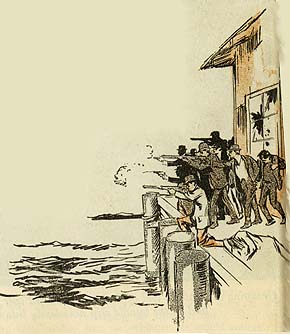What happened that day in Everett
Essay: What happened that day in Everett
Sample Searches
Other Resources
STRIKES! Labor and Labor History in the Puget Sound
Industrial Workers of the World
Center for the Study of the Pacific Northwest
Tacoma Public Library Northwest Room, Unsettling Events database
Michigan State University Special Collections, American Radicalism Collection Digital Images
Everett Public Library: Northwest Digital Collections: The Everett Massacre

Image not in database
The Everett Massacre was a disaster from any perspective. On November 5, 1916 a group of young Industrial Workers of the World (I.W.W.) union members some 260 strong bought passage on the steamer Verona, bound from Seattle for Everett, Washington. Forty more I.W.W. members followed on the steamer Calista. Ostensibly they were headed to Everett for a free-speech rally. The rally was in response to a brutal attack on I.W.W. members by Snohomish County Sheriff Don McRae and his deputies just a few days before. The rally was never-to-be as the Verona was met at the dock by the Sheriff and 125-250 armed and overzealous deputies, theoretically there to defend law and order. Who fired the first shot will always be a matter of dispute, but ultimately it doesn't matter which side began the gunfire. A confrontation of this size was a tragedy waiting to happen. After the first shot, mayhem ensued. The I.W.W.s, largely (but not completely) unarmed, ran to the far side of the boat, nearly causing the Verona to capsize. The captain of the Verona hid behind a safe, under a mattress. When it became clear that men were dying and the gunfire was not stopping, I.W.W. member James Billings forced the ship's engineer, at gunpoint, to back out of the dock and return to Seattle, thereby ending the brief battle. On their way back, the Verona passed the Calista, and advised them to turn back, which they did. Five I.W.W. members (Abraham Rabinowitz, Hugo Gerlot, Gus Johnson, Felix Baran and John Looney) were killed, as were two of the deputies (C.O. Curtis and Jefferson Beard). Dozens more from each side were wounded. At least 6 additional I.W.W. members disappeared and were either drowned after falling overboard, or shot while in the water. Curiously, neither faction ever paid much attention to these men.
What happened afterward in Seattle

Image not in database
Upon their return, the I.W.W. members surrendered peacefully to the Seattle police, having thrown what guns and ammunition they had overboard, and were either hospitalized or jailed. It was eventually decided to try 74 of the I.W.W.s, with Thomas Tracy being the first to be tried, on the charge of conspiracy to commit the murder of Sheriff's Deputy Jefferson Beard. Originally the charge was to have been for the death of Deputy C.O. Curtis, as well, but forensic evidence later indicated that Curtis was most likely killed by one of his fellow deputies, so that charge was quietly dropped. The Tracy trial was complex, and covered a wider range of topics than the murder charge indicated. The I.W.W. perceived the trial as a class struggle, the proletariat against the establishment, and to a large degree, they were correct in this view. This made for a lengthy trial for the time (March 5-May 5, 1917), at the end of which Tracy was found Not Guilty. There was no appeal, and no trial of any of the other 73 men being held. Nor were charges ever made against McRae and the deputies. For the most part, the whole embarrassing incident has been quietly forgotten.
* Images this page copyright Sunset, the Pacific Monthly, February 1917, Vol 38, p.16.
* Pacific Northwest Quarterly, April 1980, Volume 71, Number 2. Bloody Sunday Revisited, William J. Williams; pp.50-53
